TRX Training: indoor core workouts and moves to practise
TRX is a suspension trainer that's like having your own portable gym in the comfort of your own home. Here's why it could work for you, and some key exercises ideal for cyclists
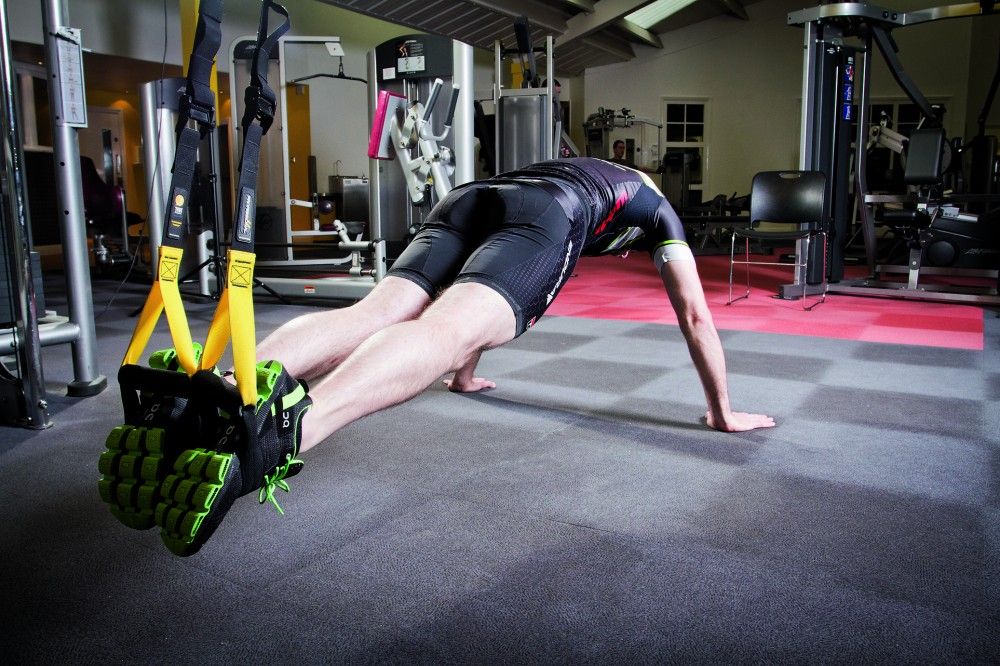
We've been expounding the benefits of core strength for years. Research is becoming more prevalent, professional cyclists and teams are starting to adopt these studies’ suggestions into their training plans, and the science is slowly starting to filter down into the amateur ranks.
Finally, after many years, resistance and strength programmes are being more widely accepted and less feared; cyclists are starting to wake up to how valuable core work can be. But this is not another feature about core strength. No, this is a feature about a piece of apparatus that is taking over the fitness world.
We often encourage people to keep riding even when it's raining, but sometimes indoor workouts are the only answer. When you simply can't face another session on the turbo, a core conditioning session is a great way to build form and condition without turning a pedal.
>>> Scroll down for TRX core workouts
Trusted source
It was during an interview with British Cycling’s strength-and-conditioning coach Martin Evans that our sister publicationCycling Fitness was compelled to take notice.
“Have you ever seen those TRX systems? It’s a great piece of kit, and something I highly recommend,” said Evans.
Now, when one of the top strength and conditioning coaches recommends something, you listen.
Get The Leadout Newsletter
The latest race content, interviews, features, reviews and expert buying guides, direct to your inbox!
TRX training uses a suspension trainer, which refers to a type of strength training apparatus that uses a combination of ropes and webbing to allow the user to work against their own body weight and gravity.
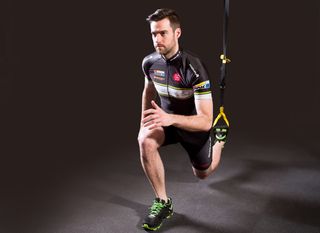
While rope training has been around for many, many years, it was former Navy Seal and Stanford MBA graduate Randy Hetrick who developed a product and brought it to market during the Nineties. Since then, the TRX has gone from strength to strength, and is used across many sports and gyms worldwide. But what is so good about it, and how are cyclists able to use it to their advantage?
We spoke to Chris Pritchard, who not only uses it but has taken courses in it as well. Pritchard competed for Scotland at the Commonwealth Games as a track sprinter in 2010 and 2014.
“I’d like to explain it [the TRX] as a whole gym,” says Pritchard. “If you were to look at it, you may think it’s just a core-building tool. But there’s actually a lot more to it than that. You’ve got people using it for strength — I use it for strength endurance, because you can target a lot more of the stabilising muscles that help stabilise the joints in place. These muscles don’t necessarily get the workout they need when you’re doing a squat or a bench press — you’re just using the bigger part of the muscles. The attachments and the tendon points don’t get activated. With the TRX, those muscles have got to fire up. If they don’t, then you’re in trouble in terms of the suspension element of it. It really does pull everything together, as opposed to just focusing on brute strength."
Benefits for cyclists
“I think a lot of cyclists worry that if they go in a gym, they’re going to bulk up and put weight on. Road riding is all about being as light as possible but, provided you know what you’re doing and doing it right, then this is probably one of, if not the, best tools for road riders to increase their stabilisation and their strength endurance.
“When you’re on the drops a lot, there’s a lot of demand on your upper body, although you might not think it, and it can get fairly tiring. I know when I’m out riding on the drops, I start to feel it in my triceps and in my shoulders. That’s where the TRX — a little 20-30-minute circuit — can really benefit.”
This isn’t a wacky gimmick. It’s a proper piece of equipment that can really help you. Not only that, but it’s something different and fresh from your usual mundane strengthening exercises such as the plank and squats. More importantly, there is room for progression.
“It just takes everything to a different level,” says Pritchard. “A plank is a plank. There are not many variations with it. But if you pop yourself in the TRX, it opens up more types of exercises.
“You can put your feet in it, and you lose the stabilisation from their contact with the ground, or put your wrists and hands in it, and you lose the stabilisation from there — one hand in, one hand out. It opens the spectrum up, and brings in more stabilising muscles, which you wouldn’t normally use in floor-based stabilisation exercises.”
Building it up
We often regard strength training as something to do when the weather outside is so bad we don’t want to ride, and that's understandable. During the season, training for road cycling should focus on miles and high-end training. And while strength exercises should be incorporated into your weekly programme, they often get ignored. An hour’s blast on the turbo is far easier to do than travelling to the gym, getting changed, working out, showering and coming home. But this is where the TRX is so useful.
“It is something you would use more in the winter for strength and conditioning. Not necessarily bulking up, but focusing on leg strength, as that’s something you can’t really work on during the summer when you’re riding more,” continues Pritchard.
“But it’s really effective during the summer. And it can be used as a maintenance tool to be able to chuck into your bag when you go racing, or if you’ve got a sportive. It weighs nothing, and takes up very little space. You can take it to your hotel room or wherever you’re staying, and bang out a core exercise routine.
“The core is something you need to keep fired and ticking over. That’s the main thing. I know a lot of road riders who as soon as they start racing, everything else goes out of the window. And it shouldn’t. I’ve just read Bradley Wiggins’s book and he’s so regimented in his core work.
“And there’s no excuse with the TRX, as you can take it with you. You couldn’t lug around a cable resistance machine, you couldn’t even lug around a gym ball. All these pieces of kit limit you to where you can use them. With the TRX, you can hook it on the door, or find somewhere to hang it from, and you’re away and providing you’ve got the space, you’ve got a whole gym at your disposal.”
TRX core exercises for cyclists
Below we look at three exercises that are ideal for cyclists and can get you underway with core conditioning
TRX Atomic Push Up
The atomic push-up is a very effective core exercise. Firstly it challenges you to hold a high plank position in an isometric contraction (a muscle contraction with no movement). This is great to fire up those deep core muscles which will help keep you solid in the saddle. Secondly we introduce a knee tuck. As you bring the knees into your chest, you move in a way that strengthens those deep core muscles as well as bringing in the smaller stabilising muscles to help keep everything in line. Thirdly, after extending the legs back into the plank position, we
go straight into a press-up, and simply repeat.
Adding this movement into your regular high plank takes the exercise to a whole new level and creates more instability for that core to really work at its maximum, also bringing in shoulder stability as well as a strength-based workout for your chest and triceps.
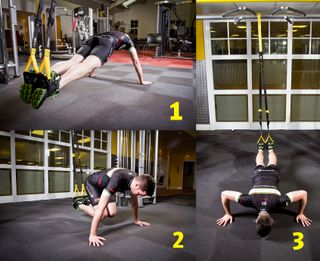
1 The foot cradle should be set to mid calf length. Place feet in foot cradles and come in to press up position, engaging your core and squeezing those glutes. Hold the plank position for two seconds.
2 Keeping your back straight, drive the knees in to your chest, slowly and controlled, before returning legs to original position.
3 Once back in plank position, bend from the elbow to drop your chest to the floor while maintaining correct posture and keeping back straight. Press up and back to start position. Repeat eight to 12 times each set.
TRX Sprinter Start
The TRX sprinter start combines strength with power, a great tool in advancing your explosive sprints and attacks. We use the TRX to help drop into a sprinter’s start position by taking the handles under your arms and dropping your body weight into the system as you step back and assume the position. From this position, we can generate power through the front leg and produce a hop as we explode from the rear leg. The explosive nature of this movement really does test your coordination and recovery abilities. Being suspended, you can create a tougher workout physically and proprioceptively by stepping further back and placing more body weight through the TRX.
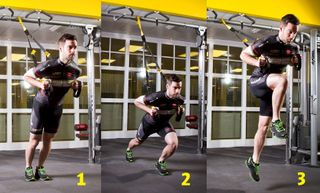
1 Place straps under arms with hands beside your chest. Walk back to a 45° angle staying on the balls of your feet.
2 Reach back with one leg while bending the front leg until knee is at 90°.
3 Drive through the ball of your foot exploding into a hop as you extend those hips through to finish the move. Repeat 10 times per leg.
TRX Side Plank
The TRX side plank is another isometric hold position and similar to the standard plank position, only now you will rotate your body to one side placing one foot in front of the other and place your weight through you elbow which is directly under your shoulder. From here you contract your abdominal muscles and raise your hip to create a straight line from your ankles through your hips to your head. This hold is targeting the internal and external obliques. These are the muscles that are sometimes overlooked while performing core exercises. This muscle group runs down the side of your main abdominal wall and creates support and strength in your core. If this hold isn’t challenging enough then you can simply create some movement, which will definitely provide you with the workout you’re looking for. Take your free arm and slowly rotate your shoulder forwards towards the ground, taking the arm under your body and slowly returning it to a raised position. This move is sure to work your core to the maximum.
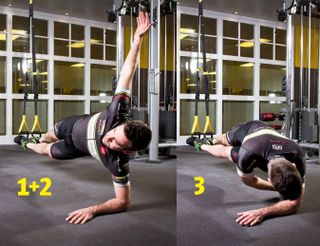
1 Place both feet in the foot cradles, turning your body to face side-on to the TRX.
2 Make sure your elbow is directly under your shoulder, raise your hip to create a straight posture from ankle to neck. Raise free arm in the air to balance.
3 If you wish, hold this position for 30 to 60 seconds before repeating on the other side. Otherwise, take your raised arm and slowly rotate shoulder forward to the floor until arm is under your body, slowly return the raised position and repeat eight to 12 times.
Original article by Robert Hicks and Chris Pritchard
For more, see trxtraining.com

Stretching techniques
Often overlooked and rarely overdone, correct stretching techniques can not only help you to ride further, they can make you

Four of the best indoor cycling sessions for turbo training
The boredom of the turbo-trainer is the cyclist’s annual test of motivation: here's how to both enjoy indoor training and

Turbo trainers: Seven of the best

Thank you for reading 20 articles this month* Join now for unlimited access
Enjoy your first month for just £1 / $1 / €1
*Read 5 free articles per month without a subscription

Join now for unlimited access
Try first month for just £1 / $1 / €1
-
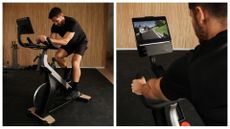 Tech of the week: an affordable smart bike from Decathlon, a super-chunky Garmin watch, wavy carbon wheels, a carbon fork for the adventurous and pink tyres for dashing Brompton owners
Tech of the week: an affordable smart bike from Decathlon, a super-chunky Garmin watch, wavy carbon wheels, a carbon fork for the adventurous and pink tyres for dashing Brompton ownersA round-up of this week's new, cool tech from Decathlon, Garmin, VeloElite, No. 6 Composites and Goodyear
By Luke Friend Published
-
 Tweets of the week: Peter Sagan signs up for Strictly Come Dancing
Tweets of the week: Peter Sagan signs up for Strictly Come DancingHe's quick on a bike, but how good's his rumba?
By Tom Davidson Published